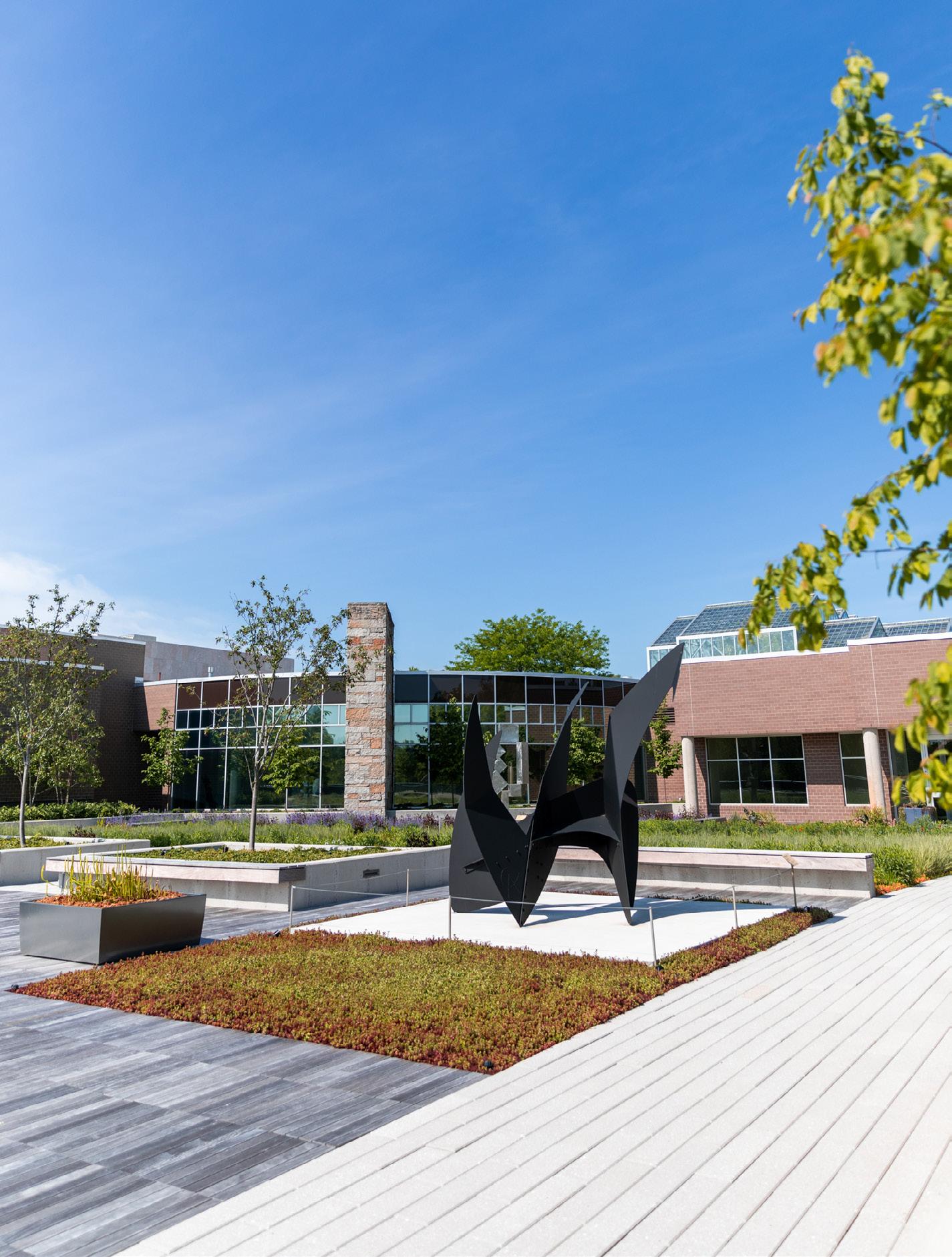
4 minute read
FROM THE HIRSHHORN MUSEUM TO THE ROOFTOP
On an early March day, I took my first stroll of the year through the Stuart and Barbara Padnos Rooftop Sculpture Garden. While this unique space was still closed to the public for the winter, its walkway was mostly clear of ice, except for a small stretch hidden away from the sun. Nature was starting to emerge, with the earliest signs of spring coming into new life. Some of last year’s tall grasses were still standing, and from the wetlands, I heard the familiar first sounds of geese arriving from their southern travels. As I took in this serene scene, it struck me that the picture I was forming in my mind’s eye would be incomplete without the presence of four sculptures embedded into this changing landscape.
Since 2019, these four sculptures have been on loan to Frederik Meijer Gardens & Sculpture Park from the Hirshhorn Museum and Sculpture Garden in Washington, D.C., the Smithsonian Institution’s premier venue for modern and contemporary art. We were able to borrow these masterworks of modern sculpture while the Hirshhorn’s sculpture garden undergoes renovation—and I’m happy to report that the loan was just extended for another year.
Advertisement
These four masterpieces by Henry Moore, Alexander Calder, Marino Marini and David Smith represent some of the finest examples of modern sculpture found in any collection in the United States. Each one reveals insights into the dramatic and historic transformation of American and European sculpture after World War II.
When Italian artist Marino Marini first began to exhibit his horse and rider sculptures in the United States, they struck a chord with critics and collectors alike. The works were reminiscent of classic monumental equestrian sculpture, yet Marini’s fusion of form, space, volume and movement was entirely modernist. The Hirshhorn’s Horse and Rider bronze sculpture is a particularly dynamic example. The rider precariously leans backward, arms outstretched, while the horse thrusts its head in a strong upward movement. This abrupt interplay of vertical, diagonal and horizontal lines is a strong indication of how Marini broke with classical tradition to create what some have called an “anti-monument”.
Sited on the other side of the rooftop garden is another figurative bronze, Draped Reclining Figure by British artist Henry Moore, which is positioned clearly in dialogue with Marini’s Horse and Rider. Both artists designed these bronzes in the early 1950s, and both works present an archaic-looking figure in modern, abstracted style. As you take them in, notice the great differences in the way these artists articulated the body in space. The weight and balance of each sculpture points into opposite directions. Draped Reclining Figure is lifting her body up by her arms and legs yet her weight remains attached to the ground. For Moore, this emphasis of the inner vitality and inner strength of the figure was very important. It was his balance in expressing inside and outside form that made him a master of twentieth-century sculpture.
These works are complemented by two significant abstract sculptors of the last century, David Smith and Alexander Calder. Smith was an American artist from the Midwest who joined the abstract expressionist movement in New York. He developed his own expressionistic style welding industrial metal into three-dimensional collages. Exploring new abstract forms in ever-changing constellations, Smith became one of the most innovative sculptors of his generation. Cubi XII is a brilliant example of his late sculptures, which combine stainless steel cubes into gravity-defying abstractions floating in space. The texture of the stainless steel itself is dazzling, revealing the artist’s burnishing of the surface.
The grouping of Hirshhorn sculptures is completed by Alexander Calder’s whimsical Sky Hooks, which is fabricated with thin sheets of steel. Calder had a fascinating artistic career that started with toy constructions, miniature circuses and wire portraits culminating in abstract sculptures that were either suspended (mobiles) or standing on the ground (stabiles). Sky Hooks dates from Calder’s late career, when he designed many large sculptures for museums, corporate lobbies and city plazas. While smaller in scale than his large and monumental La Grande Vitesse in downtown Grand Rapids, Sky Hooks shares a similar aesthetic. Both sculptures are abstract and simultaneously suggestive of animal parts or other objects from the natural world. Depending on perspective, elements of Sky Hooks resemble either fins or anchor hooks.
It’s important to note that, except for David Smith, each of these artists has a companion piece—or what I like to call a “cousin”—in our permanent sculpture collection at Meijer Gardens. Make sure to see Alexander Calder’s Polychrome Lures in the new Welcome Center, and venture outside to the Sculpture Park to view Marini’s Juggler and two bronzes by Moore, Bronze Form and Working Model for Divided Oval: Butterfly.
Upon leaving the Padnos Rooftop Sculpture Garden that early spring day, I encountered one of our horticulturists who shared that this quiet garden would be bustling with guests later that weekend. While I did not physically jump, my heart leapt at that thought. Make sure you make time to revel in this rooftop on your next visit.
Essay by Jochen Wierich, Ph.D., Curator of Sculpture & Sculpture Exhibitions

Alexander Calder. Sky Hooks. c. 1962. Steel and paint. Hirshhorn Museum and Sculpture Garden, Smithsonian Institution, Washington, DC, Gift of Mrs. Jerome L. Greene, 2001.
Kirstin Volkening

